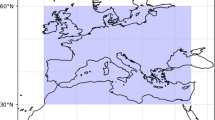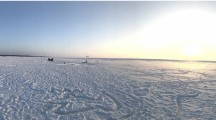Abstract
Statistical analyses of the seasonal and temporal distributions of turbulence events in the Santiago (Chile)–Mendoza (Argentina) route region are constructed using automated in situ turbulence observation measurements of the vertical acceleration in flights from LATAM Airlines aircraft. The VRTG database contains 2485 records over 22 months, from March 2018 to December 2019. Although winter in the Southern Hemisphere (SH) was the period with the greatest occurrence of turbulence in the Andes, severe turbulence was more frequent in the summer and early autumn in SH. Through synoptic-scale analysis generated by the post-processing of the Global Forecasting System, it was possible to determine that the unusual severe turbulence events are not related to either convectively induced turbulence or mountain wave turbulence, but to the upper-level atmospheric mechanisms that caused severe clear air turbulence by an interaction tripod between the Bolivian high, upper-level jet stream, and topography.







Source: adapted from CPTEC (http://satelite.cptec.inpe.br/); b streamlines (blue lines), wind speed (kt) (black dotted line), and vertical wind shear (10−3 s−1) (hatched area in color) for the FL300; c vertical section at 31.5° S from 1000 to 100 hPa between 64° W and 70° W of the wind (kt) on dewlap, potential temperature (k) (red lines), and vertical speed (m/s) (hatched area in color). The study area is highlighted in the rectangle, and in “x” the positioning of the aircraft that registered the VRTG class 3
Similar content being viewed by others
Availability of data and material
Not applicable.
Code availability
Not applicable.
References
Almeida, V. A., França, G. B., & Velho, H. C. (2020). Data assimilation for nowcasting in the terminal area of Rio de Janeiro. Ciência e Natura, 42, 40. https://doi.org/10.5194/amt-9-2335-2016
Andrade, K. M., & Cavalcanti, I. F. A. (2018). Atmospheric characteristics that induce extreme precipitation in frontal systems over Southeastern Brazil during summer: Observations and atmospheric model simulation. International Journal of Climatology, 38(14), 5368–5385. https://doi.org/10.1002/joc.5744
Carney, T. Q., Bedard, A. J., Brown, J. M., McGinley, J., Lindholm, T., & Kraus, M. J. (1995). Hazardous mountain winds and their visual indicators. Advisory Circular, 00–57(FAA). https://www.researchgate.net/project/Aviation-Hazards. Retrieved 9 Sept 2020
Carvalho, A. M. G. (1989). Conexões entre a circulação em altitude e a convecção sobre a América do Sul (M.Sc). Instituto Nacional de Pesquisas Espaciais (INPE), São José dos Campos.
Cavalcanti, I. F. de A., Ferreira, N. J., Dias, M. A. F. da S., & Silva, M. G. A. J. da. (2009). Tempo e clima no Brasil. São Paulo: Oficina de Textos.
Dörnbrack, A., Gerz, T., & Schumann, U. (1995). Turbulent breaking of overturning gravity waves below a critical level. Applied Scientific Research, 54(3), 163–176. https://doi.org/10.1007/BF00849114
Doyle, J. D., Shapiro, M. A., Jiang, Q., & Bartels, D. L. (2005). Large-amplitude mountain wave breaking over greenland. Journal of the Atmospheric Sciences, 62(9), 3106–3126. https://doi.org/10.1175/JAS3528.1
Dutton, J. A., & Panofsky, H. A. (1970). Clear air turbulence: A mystery may be unfolding. Science (new York, N.y.), 167(3920), 937–944. https://doi.org/10.1126/science.167.3920.937
Eick, D. (2014). Turbulence related accidents and incidents. presented at the turbulence impact mitigation workshop 2, Washington, DC: NCAR. https://ral.ucar.edu/sites/default/files/public/events/2014/turbulence-impact-mitigation-workshop-2/docs/eick-turbulencerelatedaccidents.pdf. Retrieved 9 Sept 2020
Ellrod, G. P., & Knox, J. A. (2010). Improvements to an operational clear-air turbulence diagnostic index by addition of a divergence trend term. Weather and Forecasting, 25(2), 789–798. https://doi.org/10.1175/2009WAF2222290.1
Figueroa, S. N., Satyamurty, P., & Silva Dias, P. L. (1995). Simulations of the summer circulation over the South American region with an eta coordinate model. Journal of the Atmospheric Sciences, 52, 1573–1584. https://doi.org/10.1175/1520-0469(1995)052%3c1573:SOTSCO%3e2.0.CO;2
França, G. B., de Almeida, M. V., Bonnet, S. M., & Neto, F. L. A. (2018). Nowcasting model of low wind profile based on neural network using SODAR data at Guarulhos Airport, Brazil. International Journal of Remote Sensing, 39(8), 2506–2517. https://doi.org/10.1080/01431161.2018.1425562
França, G. B., de Almeida, M. V., & Rosette, A. C. (2016). An automated nowcasting model of significant instability events in the flight terminal area of Rio de Janeiro, Brazil. Atmospheric Measurement Techniques, 9(5), 2335–2344. https://doi.org/10.5194/amt-9-2335-2016
Gultepe, I., Sharman, R., Williams, P. D., Zhou, B., Ellrod, G., Minnis, P., Trier, S., et al. (2019). A review of high impact weather for aviation meteorology. Pure and Applied Geophysics, 176(5), 1869–1921. https://doi.org/10.1007/s00024-019-02168-6
Harrison, H. T. (1957). Forecasting the mountain wave at Denver, Colorado. Denver, United Airlines Met. Circular no 42
Jaeger, E. B., & Sprenger, M. (2007). A Northern Hemispheric climatology of indices for clear air turbulence in the tropopause region derived from ERA40 reanalysis data. Journal of Geophysical Research: Atmospheres. https://doi.org/10.1029/2006JD008189
Kaplan, M. L., Huffman, A. W., Lux, K. M., Cetola, J. D., Charney, J. J., Riordan, A. J., Lin, Y.-L., et al. (2005). Characterizing the severe turbulence environments associated with commercial aviation accidents. Part 2: Hydrostatic mesoscale numerical simulations of supergradient wind flow and streamwise ageostrophic frontogenesis. Meteorology and Atmospheric Physics, 88(3), 153–173. https://doi.org/10.1007/s00703-004-0079-6
Kim, J.-H., & Chun, H.-Y. (2010). A numerical study of clear-air turbulence (CAT) encounters over South Korea on 2 April 2007. Journal of Applied Meteorology and Climatology, 49(12), 2381–2403. https://doi.org/10.1175/2010JAMC2449.1
Kim, J.-H., Chun, H.-Y., Sharman, R. D., & Trier, S. B. (2014). The role of vertical shear on aviation turbulence within cirrus bands of a simulated western Pacific cyclone. Monthly Weather Review, 142(8), 2794–2813. https://doi.org/10.1175/MWR-D-14-00008.1
Kim, J.-H., Sharman, R., Strahan, M., Scheck, J. W., Bartholomew, C., Cheung, J. C. H., Buchanan, P., et al. (2018). Improvements in nonconvective aviation turbulence prediction for the world area forecast system. Bulletin of the American Meteorological Society. https://doi.org/10.1175/BAMS-D-17-0117.1
Knox, J. A. (1997). Possible mechanisms of clear-air turbulence in strongly anticyclonic flows. Monthly Weather Review, 125(6), 1251–1259. https://doi.org/10.1175/1520-0493(1997)125%3c1251:PMOCAT%3e2.0.CO;2
Lane, T. P., Sharman, R. D., Trier, S. B., Fovell, R. G., & Williams, J. K. (2012). Recent advances in the understanding of near-cloud turbulence. Bulletin of the American Meteorological Society, 93(4), 499–515. https://doi.org/10.1175/BAMS-D-11-00062.1
LATAM. (2019). Vertical acceleration high in flight (pp. 485–486).
Lenters, J. D., & Cook, K. H. (1997). On the origin of the Bolivian high and related circulation features of the South American climate. Journal of the Atmospheric Sciences, 54(5), 656–678. https://doi.org/10.1175/1520-0469(1997)054%3c0656:OTOOTB%3e2.0.CO;2
Lyra, A., & ChanDereczynski, C. S. C. P. (2007). Indicadores de turbulência a partir de previsões do modelo regional ETA. Revista Brasileira De Meteorologia, 22(2), 161–182. https://doi.org/10.1590/S0102-77862007000200003
Marengo, J. A., Soares, W. R., Saulo, C., & Nicolini, M. (2004). Climatology of the low-level jet east of the Andes as derived from the NCEP–NCAR reanalyses: Characteristics and temporal variability. Journal of Climate, 17(12), 2261–2280. https://doi.org/10.1175/1520-0442(2004)017%3c2261:COTLJE%3e2.0.CO;2
Marlton, G. J. (2016). On the development, characterisation and applications of a balloon-borne atmospheric turbulence sensor (PhD). University of Reading. http://centaur.reading.ac.uk/68910/. Retrieved 9 Sept 2020
Mello, I. B. F. (2015). Climatologia e Estudo de Caso da Turbulência de Céu Claro a Partir de Registro de Aeronaves: Análise de dados observacionais e de modelagem (M.Sc). Instituto Nacional de Pesquisas Espaciais (INPE), São José dos Campos. http://mtc-m21b.sid.inpe.br/col/sid.inpe.br/mtc-m21b/2015/03.13.04.06/doc/publicacao.pdf. Retrieved 9 Sept 2020
Menegardo-Souza, F. (2018). Avaliação dos Resultados do Ábaco de Harrion no Diagnóstico de Turbulência no Cruzamento da Cordilheira dos Andes (Specialization Course). Instituto de Controle do Espaço Aéreo (ICEA), São José dos Campos. https://www.anac.gov.br/assuntos/setor-regulado/profissionais-da-aviacao-civil/meteorologia-aeronautica/arquivos/MET001V_Final_RevisaoBanca_2TMENEGARDO.pdf. Retrieved 9 Sept 2020
Nastrom, G. D., & Fritts, D. C. (1992). Sources of mesoscale variability of gravity waves. Part I: Topographic excitation. Journal of the Atmospheric Sciences, 49(2), 101–110. https://doi.org/10.1175/1520-0469(1992)049%3c0101:SOMVOG%3e2.0.CO;2
National Weather Service. (2020). The jet stream. https://www.weather.gov/jetstream/jet. Retrieved 6 Sept 2020
Norte, F. A. (2015). Understanding and forecasting Zonda wind (Andean Foehn) in Argentina: A review. Atmospheric and Climate Sciences, 5(3), 163–193. https://doi.org/10.4236/acs.2015.53012
Paulucci, T. B., França, G. B., Libonati, R., & Ramos, A. M. (2019). Long-term spatial-temporal characterization of cloud-to-ground lightning in the metropolitan region of Rio de Janeiro. Pure and Applied Geophysics, 176(11), 5161–5175. https://doi.org/10.1007/s00024-019-02216-1
Pezzi, L. P. P., Rosa, M. B., & Batista, N. N. M. (2020). A Corrente de Jato sobre a América do Sul. CPTEC. http://climanalise.cptec.inpe.br/~rclimanl/boletim/cliesp10a/jatclim.html. Retrieved 11 Sept 2020
Reboita, M. S., Gan, M. A., da Rocha, R. P., & Ambrizzi, T. (2010). Regimes de precipitação na América do Sul: Uma revisão bibliográfica. Revista Brasileira De Meteorologia, 25(2), 185–204. https://doi.org/10.1590/S0102-77862010000200004
Reinecke, P. A., & Durran, D. R. (2008). Estimating topographic blocking using a froude number when the static stability is nonuniform. Journal of Atmospheric Sciences, 65, 1035. https://doi.org/10.1175/2007JAS2100.1
Reiter, E. R. (1969). Jet-stream meteorology. University of Chicago Press.
Sharman, R., Cornman, L., Meymaris, G., & Pearson, J. (2014). Description and derived climatologies of automated in situ eddy-dissipation-rate reports of atmospheric turbulence. Journal of Applied Meteorology and Climatology, 53, 1416–1432. https://doi.org/10.1175/JAMC-D-13-0329.1
Sharman, R., & Pearson, J. M. (2017). Prediction of energy dissipation rates for aviation turbulence. Part I: Forecasting nonconvective turbulence. Journal of Applied Meteorology and Climatology, 56, 317–377. https://doi.org/10.1175/JAMC-D-16-0205.1
Sharman, R., Tebaldi, C., Wiener, G., & Wolff, J. (2006). An integrated approach to mid- and upper-level turbulence forecasting. Weather and Forecasting, 21, 268–287. https://doi.org/10.1175/WAF924.1
Sharman, R., & Trier, S. B. (2019). Influences of gravity waves on convectively induced turbulence (CIT): A review. Pure and Applied Geophysics, 176(5), 1923–1958. https://doi.org/10.1007/s00024-018-1849-2
Sharman, R., Trier, S. B., Lane, T. P., & Doyle, J. D. (2012). Sources and dynamics of turbulence in the upper troposphere and lower stratosphere: a review. Geophysical Research Letters. https://doi.org/10.1029/2012GL051996
Shi, W., Higgis, R. W., Yarosh, E., & Kousky, V. E. (2000). The annual cycle and variability of precipitation in Brazil. NCEP/Climate Prediction Center Atlas, 9. https://www.cpc.ncep.noaa.gov/research_papers/ncep_cpc_atlas/9/atlas9.htm. Retrieved 6 Sept 2020
Silva, A. R. (2004). Ondas Orográficas Sobre a Cordilheira dos Andes em Latitudes Subtropicais: Estudo de caso (M.Sc). Instituto Nacional de Pesquisas Espaciais (INPE), São José dos Campos. http://mtc-m16.sid.inpe.br/col/sid.inpe.br/jeferson/2004/05.27.09.45/doc/publicacao.pdf. Retrieved 9 Sept 2020
Smith, R. B. (1989). Mountain-induced stagnation points in hydrostatic flow. Tellus A, 41A(3), 270–274. https://doi.org/10.1111/j.1600-0870.1989.tb00381.x
Smith, R. B. (2019). 100 years of progress on mountain meteorology research. Meteorological Monographs, 59, 20.1–20.73. https://doi.org/10.1175/AMSMONOGRAPHS-D-18-0022.1
Storer, L. N., Williams, P. D., & Gill, P. G. (2019). Aviation turbulence: Dynamics, forecasting, and response to climate change. Pure and Applied Geophysics, 176(5), 2081–2095. https://doi.org/10.1007/s00024-018-1822-0
Stull, R. B. (1988). An introduction to boundary layer meteorology. Atmospheric and Oceanographic Sciences Library. Springer Netherlands.
Turner, J. (1999). Development of a mountain wave turbulence prediction scheme for civil aviation. Met office forecasting research technical report, 265.
Vásquez, H., & Falcón, N. (2015). Ondas de montaña en la capa límite planetaria de la región andina venezolana. Revista Brasileira De Meteorologia, 30(3), 241–253. https://doi.org/10.1590/0102-778620130626
WMO. (1973). The airflow over moutains. WMO N°355. https://library.wmo.int/doc_num.php?explnum_id=1814. Retrieved 6 Sept 2020
Wolff, J. K., & Sharman, R. (2008). Climatology of upper-level turbulence over the contiguous United States. Journal of Applied Meteorology and Climatology, 47(8), 2198–2214. https://doi.org/10.1175/2008JAMC1799.1
Zhou, J., & Lau, K.-M. (1998). Does a monsoon climate exist over South America? Journal of Climate, 11(5), 1020–1040. https://doi.org/10.1175/1520-0442(1998)011%3c1020:DAMCEO%3e2.0.CO;2
Zimmermann, D. F. R. (2017). Climatologia do jato subtropical na América do Sul (M.Sc). Universidade de São Paulo (USP), São Paulo. https://www.iag.usp.br/pos/sites/default/files/d_diego_f_r_zimmermann_corrigida.pdf. Retrieved 9 Sept 2020
Acknowledgements
This study is funded by the Department of Airspace Control (DECEA), through the Brazilian Organization for the Scientific and Technological Development of Airspace Control (CTCEA) (Grant: 002-2018/Foundation for the Coordination of Projects, Research and Technological Studies (COPPETEC)_CTCEA). In addition, the authors thank LATAM Airlines Brazil for providing VRTG data.
Funding
This study is funded by the Department of Airspace Control (DECEA), through the Brazilian Organization for the Scientific and Technological Development of Airspace Control (CTCEA) (Grant: 002-2018/Foundation for the Coordination of Projects, Research and Technological Studies (COPPETEC)_CTCEA).
Author information
Authors and Affiliations
Contributions
Not applicable.
Corresponding author
Ethics declarations
Conflict of interest
Not applicable.
Additional information
Publisher's Note
Springer Nature remains neutral with regard to jurisdictional claims in published maps and institutional affiliations.
Rights and permissions
About this article
Cite this article
Menegardo-Souza, F., França, G.B., Menezes, W.F. et al. Synoptic Patterns of Unusual Severe Turbulence Events in the Santiago (Chile)–Mendoza (Argentina) Route Region in Summer in the Southern Hemisphere. Pure Appl. Geophys. 178, 3629–3643 (2021). https://doi.org/10.1007/s00024-021-02809-9
Received:
Revised:
Accepted:
Published:
Issue Date:
DOI: https://doi.org/10.1007/s00024-021-02809-9




